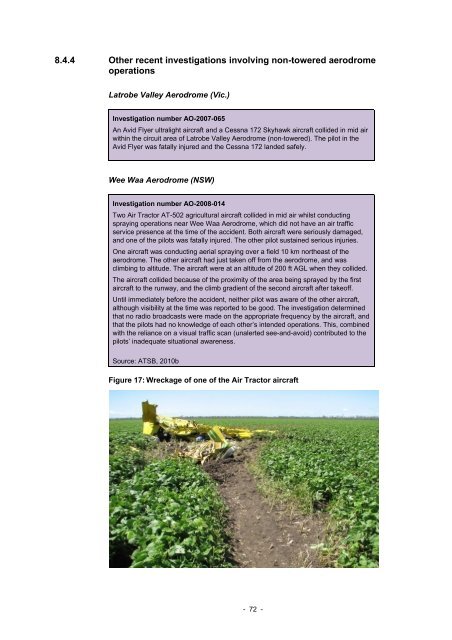Safety in the vicinity of non-towered aerodromes - Australian ...
Safety in the vicinity of non-towered aerodromes - Australian ...
Safety in the vicinity of non-towered aerodromes - Australian ...
You also want an ePaper? Increase the reach of your titles
YUMPU automatically turns print PDFs into web optimized ePapers that Google loves.
8.4.4 O<strong>the</strong>r recent <strong>in</strong>vestigations <strong>in</strong>volv<strong>in</strong>g <strong>non</strong>-<strong>towered</strong> aerodrome<br />
operations<br />
Latrobe Valley Aerodrome (Vic.)<br />
Investigation number AO-2007-065<br />
An Avid Flyer ultralight aircraft and a Cessna 172 Skyhawk aircraft collided <strong>in</strong> mid air<br />
with<strong>in</strong> <strong>the</strong> circuit area <strong>of</strong> Latrobe Valley Aerodrome (<strong>non</strong>-<strong>towered</strong>). The pilot <strong>in</strong> <strong>the</strong><br />
Avid Flyer was fatally <strong>in</strong>jured and <strong>the</strong> Cessna 172 landed safely.<br />
Wee Waa Aerodrome (NSW)<br />
Investigation number AO-2008-014<br />
Two Air Tractor AT-502 agricultural aircraft collided <strong>in</strong> mid air whilst conduct<strong>in</strong>g<br />
spray<strong>in</strong>g operations near Wee Waa Aerodrome, which did not have an air traffic<br />
service presence at <strong>the</strong> time <strong>of</strong> <strong>the</strong> accident. Both aircraft were seriously damaged,<br />
and one <strong>of</strong> <strong>the</strong> pilots was fatally <strong>in</strong>jured. The o<strong>the</strong>r pilot susta<strong>in</strong>ed serious <strong>in</strong>juries.<br />
One aircraft was conduct<strong>in</strong>g aerial spray<strong>in</strong>g over a field 10 km nor<strong>the</strong>ast <strong>of</strong> <strong>the</strong><br />
aerodrome. The o<strong>the</strong>r aircraft had just taken <strong>of</strong>f from <strong>the</strong> aerodrome, and was<br />
climb<strong>in</strong>g to altitude. The aircraft were at an altitude <strong>of</strong> 200 ft AGL when <strong>the</strong>y collided.<br />
The aircraft collided because <strong>of</strong> <strong>the</strong> proximity <strong>of</strong> <strong>the</strong> area be<strong>in</strong>g sprayed by <strong>the</strong> first<br />
aircraft to <strong>the</strong> runway, and <strong>the</strong> climb gradient <strong>of</strong> <strong>the</strong> second aircraft after take<strong>of</strong>f.<br />
Until immediately before <strong>the</strong> accident, nei<strong>the</strong>r pilot was aware <strong>of</strong> <strong>the</strong> o<strong>the</strong>r aircraft,<br />
although visibility at <strong>the</strong> time was reported to be good. The <strong>in</strong>vestigation determ<strong>in</strong>ed<br />
that no radio broadcasts were made on <strong>the</strong> appropriate frequency by <strong>the</strong> aircraft, and<br />
that <strong>the</strong> pilots had no knowledge <strong>of</strong> each o<strong>the</strong>r’s <strong>in</strong>tended operations. This, comb<strong>in</strong>ed<br />
with <strong>the</strong> reliance on a visual traffic scan (unalerted see-and-avoid) contributed to <strong>the</strong><br />
pilots’ <strong>in</strong>adequate situational awareness.<br />
Source: ATSB, 2010b<br />
Figure 17: Wreckage <strong>of</strong> one <strong>of</strong> <strong>the</strong> Air Tractor aircraft<br />
- 72 -
















